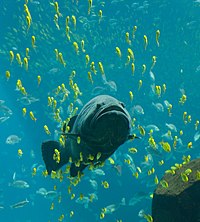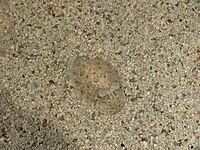Portal:Marine life/Selected Picture/Archives
| This page is currently inactive and is retained for historical reference. Either the page is no longer relevant or consensus on its purpose has become unclear. To revive discussion, seek broader input via a forum such as the village pump. |
These are all of the pictures previously selected for showing on the Marine life Portal main page.
August, 2006
[edit]
The French angelfish, Pomacanthus paru, is a member of the Marine angelfish family.
Marine angelfishes are a type of perciform fish of the family Pomacanthidae. Found on shallow reefs in the tropical Atlantic, Indian, and mostly western Pacific Ocean, the family contains seven genera and approximately 86 species. They should not be confused with the freshwater angelfish, tropical cichlids of the Amazon River basin.
September, 2006
[edit]
The giant grouper (Epinephelus lanceolatus), also known as the brindle bass and as the Queensland grouper in Australia, is the largest bony fish found in coral reefs, and the aquatic emblem of Queensland, Australia. It is found throughout the Indo-Pacific region, with the exception of the Persian Gulf. The species can grow as large as 2.7 meters (9 ft) long, weighing up to 400 kg (880 lb). They are fairly common in shallow waters and feed on a variety of marine life, including small sharks and juvenile sea turtles.
Photo taken at the Georgia Aquarium on January 23rd by Diliff with a Canon 5D and 24-105mm f/4L IS.
More on the giant grouper
October, 2006
[edit]
The Antarctic krill (Euphausia superba) is a species of krill found in the Antarctic waters of the Southern Ocean. Antarctic krill are shrimp-like invertebrates that live in large schools, called swarms, sometimes reaching densities of 10,000 - 30,000 individual animals per cubic meter.
Although the uses for and reasons behind the development of their massive black compound eyes remain a mystery, there is no doubt that Antarctic krill have one of the most fantastic structures for vision seen in nature.
Krill can shrink in size from one molt to the next, which is generally thought to be a survival strategy to adapt to scarce food supplies (a smaller body needs less energy, i.e., food). However, the animal's eyes do not shrink when this happens. The ratio between eye size and body length has thus been found to be a reliable indicator of starvation.
More on the antarctic krill
November, 2006
[edit]
The Green Sea Turtle (Chelonia mydas) is a large sea turtle, the only member of the genus Chelonia (Brongniart, 1800). This turtle grows to 1-1.5 m in length, and can weigh 200 kg, making it the largest of the hard-shelled turtles. Its distribution extends throughout tropical, subtropical and some warmer temperate waters. Females lay their eggs on traditional nesting beaches, and the turtles often bask in the sand to warm their ectothermic bodies, but otherwise this species is entirely marine.
December, 2006
[edit]
Cuttlefish are marine animals of the order Sepiida belonging to the Cephalopoda class (which also include squids, octopuses and nautilus). Although the name suggests it, cuttlefish are not fish, but molluscs.
Cuttlefish have an internal shell, large eyes, and eight arms and two tentacles furnished with denticulated suckers, by means of which they secure their prey.
January, 2007
[edit]
The Double-crested Cormorant (Phalacrocorax auritus) is a North American member of the cormorant family of seabirds. Its name is derived from the Greek words phalakros (bald) and kora (raven), and the Latin auritus (eared). Folk names of this bird include Crow-duck, Farallon Cormorant, Florida Cormorant, lawyer, shag, and Taunton turkey.
February - March, 2007
[edit]
Cuttlefish are sometimes called the chameleon of the sea because of their remarkable ability to rapidly alter their skin colour at will. Their skin flashes a fast-changing pattern as communication to other cuttlefish and to camouflage them from predators.
April, 2007
[edit]
The Magellanic penguin (Spheniscus magellanicus) is a South American penguin, breeding in coastal Argentina, Chile and the Falkland Islands, with some migrating to Brazil. It is the most numerous of the Spheniscus penguins. Its nearest relatives are the African Penguin, the Humboldt Penguin and the Galápagos Penguin.
More on the Magellanic penguin
